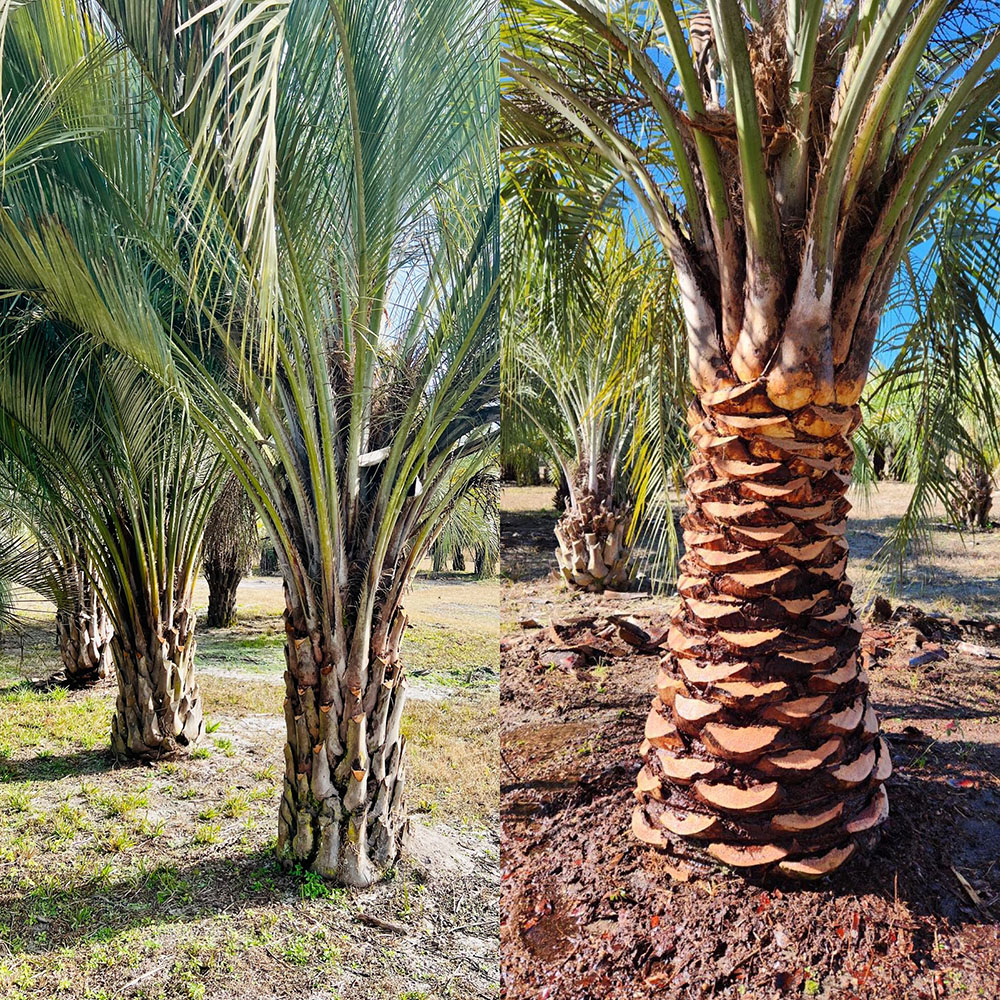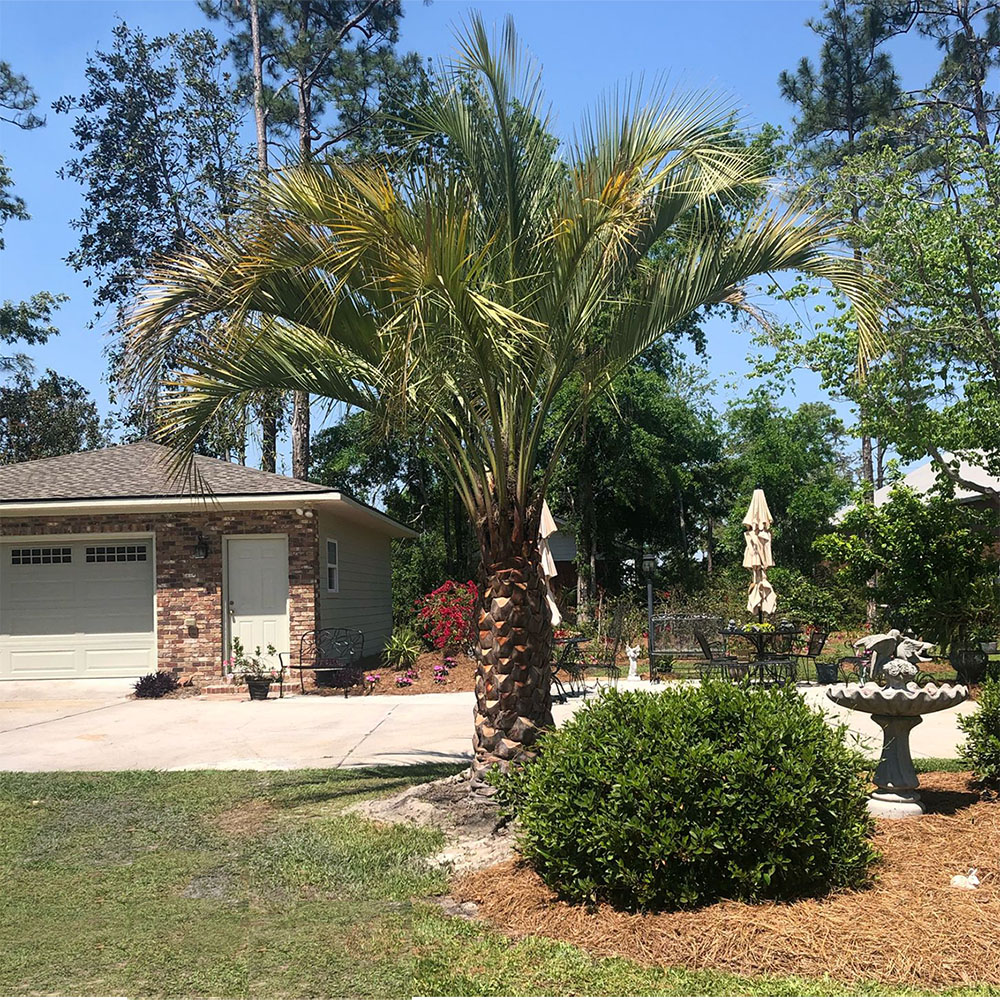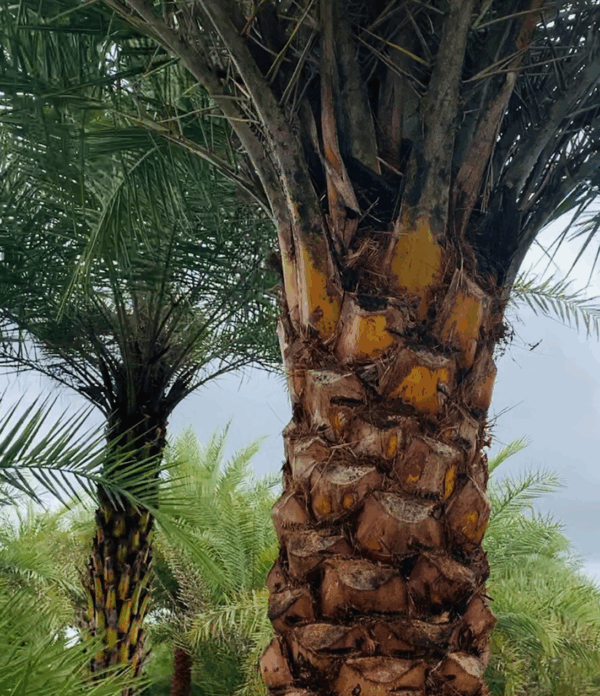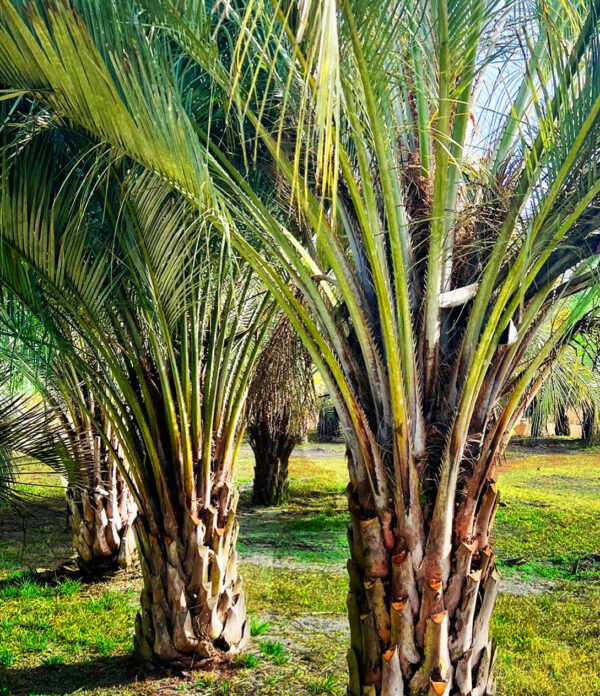The perfect cold hardy palm tree for an elegant tropical look.
Also known as the Jelly Palm, the Pindo Palm (Butia capitata) is an easy-to-care-for cold hardy palm tree that thrives in a variety of climates and conditions. Unlike many tropical palms, it can withstand cold temperatures better than most, making it an excellent choice for homeowners in USDA zones 8-10 looking to bring a lush, exotic feel to their landscape.

Fronds & Trunk
The Pindo Palm’s fronds are long and feather-like, reaching 5 to 10 feet in length and arching downward creating a drooping effect down the sides of the trunk, sometimes nearly touching the ground.
The trunk on the Pindo Palm is thick and textured, covered in old leaf bases that create a rugged, pattered appearance. It can be styled natural or diamond cut. Many landscapers prefer the diamond-cut trunk style, giving the palm a stylized, ornamental touch
 In the spring, the Jelly Palm blooms with clusters of yellow-orange flowers, adding a burst of color to your landscape.
In the spring, the Jelly Palm blooms with clusters of yellow-orange flowers, adding a burst of color to your landscape. By summer, the palm tree produces one-inch edible fruits rich in Vitamin A and beta carotene. These flavorful fruits are often used to make jelly, jam and wine making the Pindo Palm both a decorative and functional addition to any yard.
Flowers & Fruit
How tall do Pindo Palms grow?
Pindo palms typically grow between 10 and 20 feet tall. They have a slow growth rate, averaging 2-4 inches per year- growing faster in warmer areas and slower in colder regions. Pindo Palms grow almost as wide as they grow tall, making it important to leave enough space for their wide canopy, which can spread up to 15 feet.
Are Pindo palms cold hardy?
Yes! Pindo palms are among the best old hardy palm trees, and thrive in USDA zones 8-11. They can handle temperatures as low as 20 degrees F and, in some cases, even survive short drops to 10 degrees F. Their resilience makes them a great option for homeowners in mild to moderately cold climates who still want a tropical aesthetic in their landscapes.
How to Care for Pindo Palms
Pindo Palms are low-maintenance and hardy, making them easy to care for. Here’s what you need to know to keep them healthy and thriving:
- Watering: Newly planted Pindo Palms need regular watering, about 3 times per week for the first few months or until roots are established. Once established, they are drought tolerant, and require only occasional deep watering during extended dry periods. Avoid overwatering, as constant moisture around the roots can lead to root rot.
- Soil: Pindo Palms grow best in well-draining soil, such as sandy or loamy soil. Although they can tolerate a wide variety of soil types, it is best to mix coarse sand with the planting soil or at the bottom of the planting hole before placing the palm in order to facilitate drainage.
- Fertilization: After planting, wait at least three months to fertilize your palm for the first time. Use a slow-release palm fertilizer suitable for Palm trees. After the initial feeding, fertilize every 6 months to maintain strong, vibrant fronds.
- Pruning and Maintenance: Pindo Palms require minimal maintenance. Only remove dead or damaged fronds if they are completely brown. Partially green fronds are still providing nutrients to the palm tree.
Where do I plant my Pindo Palm?

Location: Pindo Palms are excellent for marking the entrance to a home in the front yard or entryway, as well as creating a tropical vibe in the backyard or poolside. Their superficial root system makes them safe to plant near hardscapes, driveways and sidewalks without causing any damage. Pindo Palms are also an ideal palm for pots, though they require transplant to a larger pot every five years or so as they grow.
Sun vs Shade: Pindo Palms prefer full sun, but can tolerate partial shade. They require a minimum of 6 hours of direct sunlight per day. Too much shade can cause the fronds to thin out and droop, reducing their lush appearance.
Space Requirements: When planting multiple Pindo Palms, leave at least 10 feet of space between each tree to allow ample room for growth and air circulation.
Why should I plant a Pindo Palm?
There are many choices when it comes to planting a tree or palm in your yard. So, why should you pick a Pindo Palm?
Pindo Palms are an excellent choice because they can tolerate colder temperatures better than other palms. They are also drought-tolerant once established, require minimal care, and adapt well to various soil types and environments.
With their silvery-blue fronds cascading over the thick, textured trunk, Pindo Palms have a unique look and color scheme that makes them a stunning focal point in any yard.
Where to buy Cold Hardy Palms?
If you are looking to buy a cold hardy palm tree, the Pindo palm is a great option! Always purchase from a reputable seller, such as Iguana Palms. Iguana Palms is a farm that specializes in Pindo and Sylvester Palms. Even more importantly, when buying cold hardy palms, it is best to choose a farm that grows them in moderately cold weather, increasing their chances of surviving when cooler temperatures set in. Iguana Palms cultivates its palms in the seasonally cool climate of North Florida, making them an excellent choice for those looking to buy palms in locations such as Orlando, Tallahassee, Ocala, and even up into South Georgia!




